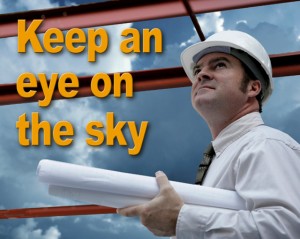Storm Safety Tips for the Job Site
Contracting, roofing, and construction companies should create and enforce a plan for lightning safety for construction workers. Dismissing the danger of storms is extremely foolhardy.
The company without a clear lightning safety plan— and insistence on its enforcement— risks not only the lives of their crew, but also substantial financial losses.
 Any outdoor job increases the risk of becoming a victim of lightning. According to a study by the NOAA (National Oceanic and Atmospheric Administration), 37% of the lightning deaths from 2006-2013 were farmers and ranchers. Construction workers and roofers accounted for 19% of lightning deaths.
Any outdoor job increases the risk of becoming a victim of lightning. According to a study by the NOAA (National Oceanic and Atmospheric Administration), 37% of the lightning deaths from 2006-2013 were farmers and ranchers. Construction workers and roofers accounted for 19% of lightning deaths.
Lightning kills 10% of the people it strikes. The 90% who survive often suffer debilitating health consequences— which may last a lifetime.
The lightning victims or their families may sue companies if dereliction is suspected. Furthermore, OSHA (Occupational Safety and Health Administration) fines companies thousands of dollars if General Duty Clause violations exist.
Tips for Lightning Safety for Construction Workers
Here are a few guidelines for protecting construction and roofing crews from death and injury in thunderstorms:
Create a Lightning Safety Policy: Add a section on lightning safety for construction crews to your company’s safety manual. Make sure all employees review the policy. Construction workers are notoriously cavalier about the dangers of lightning. Insist they promptly follow the measures recommended when a thunderstorm approaches the job site.
Keep an Eye on the Sky: Awareness of changing weather conditions is the first line of defense. Hold the construction supervisor responsible for watching the weather reports before arriving at the job each day. Weather alert apps for smart phones keep workers advised of impending thunderstorms well in advance.
React Promptly to Weather Advisories: Resist the temptation to finish the job in progress before taking shelter. Do not wait until you see lightning or rain. By the time you hear the thunder, you are already in striking distance of the lightning— even if the storm appears several miles away. Get workers off roofs, ladders, and scaffolding immediately.
Unplug Equipment: Have workers unplug any electrical tools and stow them quickly out of the way.
Take Shelter in a Building: Get all employees into a safe shelter. If the structure under construction is dried in, it may serve as a safety zone. However, ONLY if the roof and exterior walls are completed, with windows and doors installed, should the building under construction be considered a safe haven. Close all doors and windows. Stay in the center of the structure, away from windows, exterior doors, electrical wiring, and plumbing. Do not allow workers to bunch together in a tight group. Keep some space between crew members.
NEVER take shelter in an open-sided building.
Avoid small shelters, sheds, and storage buildings, which provide little protection from lightning.
Take Shelter in a Vehicle: If no building at the site is safe, have workers stay in their pickups or hard-topped cars during the storm. Do not park near trees, electrical poles, metal fences, scaffolding, or other tall objects.
Avoid rolling down windows, touching electronic equipment like the radio, or leaning on the metal doors of the vehicle. Golf carts, ATVs, plastic or fiberglass body cars, convertible automobiles, and open excavation equipment are NOT safe from lightning.
Remove Metal: Contrary to myth, metal does not attract lightning. However, when struck by lightning, metal objects may cause severe burns. Have your workers remove tool belts, metal hard hats, safety harnesses, and any other metallic objects they are wearing.
Wait: Stay in your secure location for 30 minutes after the storm has passed.
When Lightning Strikes…
Call 9-1-1 immediately if lightning strikes a construction crew member. If breathing or heartbeat has stopped, CPR-certified employees should give aid until professional help arrives. The Center for Disease Control offers detailed suggestions on treating lightning victims.
Have fire extinguishers available at the job site— especially if working on a wood-framed structure. A poor conductor of current, wood tends to catch fire when struck by lightning.
RHINO’s pre-engineered metal buildings provide safer, stronger, structures for commercial, industrial, and residential applications. Our structures offer built-in resistance to damage from termites, winds, snows, lightning, and earthquakes. We ship prefabricated metal buildings all across North America from multiple factory locations.
Contact RHINO at 940.383.9566 for a free quote, referrals, or more details about our easy-to-erect building systems.
